|
|
|
Sort Order |
|
|
|
Items / Page
|
|
|
|
|
|
|
| Srl | Item |
| 1 |
ID:
171886


|
|
|
|
|
| Summary/Abstract |
This study employs a sample of covered transactions filed with the Committee on Foreign Investment in the United States (CFIUS) of cross-border mergers and acquisitions targeting American companies based on publicly available news reports and announcements to examine the heterogeneity hypothesis in the CFIUS review process. A comparative analysis of case studies and an empirical analysis of logit regressions are performed. We also explore how CFIUS reviews may have an impact on corporations’ future mergers and acquisitions decisions in a panel data model setting. The results show that both unfair treatment in CFIUS review and the deterrent effect of CFIUS interventions have contributed to the recent sharp decline in China’s direct investment in the US
|
|
|
|
|
|
|
|
|
|
|
|
|
|
|
|
| 2 |
ID:
171884
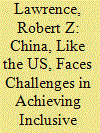

|
|
|
|
|
| Summary/Abstract |
For more than three decades the goal of becoming “the factory of the world” has been at the core of China’s development strategy. This strategy, in combination with high rates of domestic investment and low rates of consumption, has made Chinese production the most manufacturing intensive in the world. But as its wages have risen, China’s competitiveness in the most labor-intensive manufacturing industries has eroded. Its ability to assemble products remains a major source of its exports, but it has also tried to shift toward more sophisticated value-added production domestically. Chinese domestic spending has shifted away from investment toward consumption as citizens’ income has grown. Like Americans, Chinese are also spending more on services than on manufactured goods. All of these changes are fundamentally altering the structure of China’s production, reducing the role of manufacturing and increasing the skill levels of workers in manufacturing. This paper reviews the challenges posed by these developments for China’s long-term goal of achieving more inclusive growth. It presents evidence that the commonly held perceptions that Chinese manufacturing employment growth is robust are wrong. In fact, such growth has peaked and China is now following a pattern of structural change that is typical of a more mature emerging economy, in which the share of employment in manufacturing declines as workers are increasingly employed in services.
|
|
|
|
|
|
|
|
|
|
|
|
|
|
|
|
| 3 |
ID:
171887
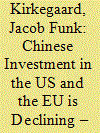

|
|
|
|
|
| Summary/Abstract |
ince peaking in 2016, Chinese outward investment, primarily to the US but also to the European Union (EU), has declined dramatically, especially in response to changes in China’s domestic rules for capital outow. Concern over growing Chinese inuence in other economies, the ascendant role of a Communist Party-led government in Beijing and the possible security implications of Chinese dominance in the high-tech sector have put Chinese outward investment under international scrutiny. This paper analyzes the recent trends in Chinese investment in the US and the EU and reviews recent political and regulatory changes both have adopted toward Chinese inward investment. It also explores the emerging transatlantic difference in the regulatory response to the Chinese information technology rm, Huawei. Concerned about national security and as part of the ongoing broader trade friction with China, the US has cracked down far harder on the company than the EU.
|
|
|
|
|
|
|
|
|
|
|
|
|
|
|
|
| 4 |
ID:
171888


|
|
|
|
|
| Summary/Abstract |
China has started to deploy its Belt and Road Initiative (BRI) in the European Union (EU), and the EU in turn has regional and global interests that intersect with the BRI’s scope. Subject to future adjustments of China’s BRI strategy, the initiative’s potential contribution to the EU requirements for infrastructure development could be signicant, even though its modalities in the EU are inevitably different from those in countries that are poorer or have more difficult financial market access. The EU’s attitude to the BRI, however, has not yet fully coalesced. Despite supercial similarities in public discourses, the EU has a profoundly distinct perspective from that of the US on the BRI, and more generally on the rise of China and its growing global inuence. For the EU, the BRI generates challenges but also potential benets. The EU should improve its ability to welcome sensible BRI projects, including through the adoption of greater reform of screening frameworks for foreign direct investment. More generally, the EU should enhance its ability to define policies independent of the US on China and the challenges resulting from China’s rise. China should also make further efforts to foster a constructive relationship with the EU.
|
|
|
|
|
|
|
|
|
|
|
|
|
|
|
|
| 5 |
ID:
171890
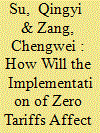

|
|
|
|
|
| Summary/Abstract |
This paper studies the employment effect of China’s possible implementation of zero tariffs by comparing China’s most-favored-nation tariffs and the tariff schedules of China’s signed free trade agreements (FTAs) with the tariff concessions in a typical high-standard FTA. It nds that there is a large gap between China’s current tariff status and a high-standard FTA, and the implementation of zero tariffs in China would have a signicant negative impact on employment in some industries. However, the employment effect of implementing zero tariffs is heterogeneous. Analysis at the industrial level shows that, although employment would drop in a few industries as a result of the implementation of zero tariffs, more jobs would be created in most industries. The overall employment effect of a zero tariff policy would be positive, creating an estimated 8.05 million jobs in China. Therefore, China should consider the adjustment costs brought by the labor movement in different industries and introduce relevant policies to deal with the employment shocks caused by zero tariffs.
|
|
|
|
|
|
|
|
|
|
|
|
|
|
|
|
| 6 |
ID:
171885
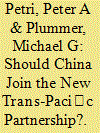

|
|
|
|
|
| Summary/Abstract |
After President Donald Trump’s ill-advised pullout from the Trans-Pacic Partnership (TPP) and despite the absence of the US, the remaining 11 Asian and Pacic countries agreed on a deal, renamed the Comprehensive and Progressive Agreement for Trans-Pacic Partnership (CPTPP). The accord took effect on 30 December 2018 and provides rigorous, up-to-date rules for Asia−Pacic trade, but excludes the region’s two biggest economies: the US and China. In this paper, we calculate that Chinese membership in the CPTPP would yield large economic and political benefits to China and other members. The CPTPP, in its current form, would generate global income gains estimated at US$147bn annually. If China were to join, these gains would quadruple to US$632bn, or a quarter more than in the original TPP with the US. But to join the CPTPP, China would have to undertake unprecedented reforms and manage complex political challenges
|
|
|
|
|
|
|
|
|
|
|
|
|
|
|
|
| 7 |
ID:
171889
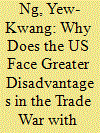

|
|
|
|
|
| Summary/Abstract |
The rhetoric used by President Trump regarding the trade war against China is rife with misinterpretation. The actual American trade decit with China is much lower if evaluated in the correct terms of value-added. The decit is mainly a result of insufcient domestic US savings. In addition, as the US dollar is an international currency which is being increasingly held as a result of increases in world population, income, prices and transaction intensity, Americans can benet from having trade decits of hundreds of billions of US dollars each year. My analysis, as well as a model of the Bank of England, reveals that the trade war is not only mutually harmful but also actually hurts America more than China. The Thucydides Trap is likely avoidable in the current nuclear era of assured mutual destruction and because China, facing many structural impediments, is still far behind America in technology and military power.
|
|
|
|
|
|
|
|
|
|
|
|
|
|
|
|
|
|
|
|
|